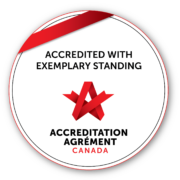
Risk Theme
Risk is one of Menno Place’s Accreditation 2018 Quality and Safety themes. It focuses on identifying safety risks inherent in the resident population we serve. The Risk theme features four Required Organizational Practices (ROPs) for Long Term Care settings that must be met to successfully complete Accreditation.
The four Risk ROPs are:
- Falls Prevention – To minimize injury from falls, a documented and coordinated approach for falls prevention is implemented and evaluated.
- Pressure Ulcer Prevention – Risk for developing a pressure ulcer is assessed and interventions to prevent pressure ulcers are implemented.
- Skin and Wound Care – An interdisciplinary and collaborative approach is used to assess clients who need skin and wound care and provide evidence‐informed care that promotes healing.
- Suicide Prevention – Residents are assessed and monitored for risk of suicide.
ROP # 1 Falls Prevention
Surveyor Question: Tell me about what the Falls Prevention Strategy is for your residents.
Evidence:
Our organization has a policy on Falls Assessment and Prevention. All nursing staff are aware of the policy and follow its procedures. Our Falls Prevention policy is based on Fraser Health’s Clinical Practice Guidelines (CPG).
- Screening all residents upon admission to determine their nature of risk for falls and related injuries and documenting in Point Click Care (PCC).
- Developing a care plan which is then implemented, monitored and evaluated regularly.
- Communicating the plan and educating residents, staff and family members about fall prevention.
- A new Falls reporting system in PCC was established Aug 1, 2018 with appropriate follow-up.
- Evaluating the effectiveness of the fall prevention and harm reduction programs by discussing incidents, causes, trends and interventions for prevention and make improvements.
- Ongoing assessment and evaluation of incident reports as appropriate.
ROP # 2 Pressure Ulcer Prevention
Surveyor Question: Tell me what processes are in place to prevent pressure ulcers.
Evidence:
Menno Place has a Wound Care policy that guides practice for the prevention and treatment of pressure ulcers. Menno Place uses the Clinical Practice Guideline (CPG) provided by Fraser Health as a basis for our pressure ulcer prevention. Each resident is assessed for risk for developing pressure ulcers and interventions are implemented to prevent and/or treat them. The CPGs guide staff in:
- All residents are screened on admission and at regular intervals including changes in status using the Braden Scale to determine Pressure Ulcer Risk.
- Care Plans are developed to assist residents in preventing and managing pressure ulcers using specific interventions for them.
- Development of pressure ulcers including interventions to:
- Prevent skin breakdown
- Minimize pressure, shear and friction
- Reposition
- Manage moisture
- Optimize nutrition and hydration
- Enhance mobility and activity
- Occurrence of pressure ulcers are reported, tracked and monitored by the organization and reported to the health authority.
- Staff, residents and family members receive education about risk factors and strategies used to prevent pressure ulcers.
- Strategies for measuring the effectiveness of pressure ulcer prevention are monitored and improved as indicated.
ROP # 3 Skin and Wound Care
Surveyor Question: Tell me what processes are in place for skin and wound care.
Evidence:
Menno Place has a skin and wound care policy entitled Wound Care. It is based on the Clinical Practice Guideline (CPG) provided by Fraser Health.
- Upon admission, each resident is assessed using the Braden Scale, to measure their status and determine treatment. The lower the scores, the greater the risk.
- Regular assessments are conducted and specifications about what dressings or treatments are appropriate for the specific condition.
- If assessments deem that skin condition is worsened or new risks identified, the care plans are updated and communicated to staff.
- Referrals are made to wound care clinicians, the dietitian and the OT to ensure everything is done to promote wound healing and appropriate treatment.
ROP # 4 Suicide Prevention
Surveyor Question: How does your organization identify and document suicide risk among residents?
Evidence:
Our organization has a policy, Resident at Risk for Suicide. The policy follows the Fraser Health CPG guidelines.
- Identification of a resident at risk of suicide upon admission through the Moving in Assessment and at regular intervals.
- Immediate safety needs of a resident at risk of suicide.
- Strategies to treat and monitor a resident at risk of suicide.
- Documentation of the risk and the development, implementation and evaluation of a resident specific care plan related to risk of suicide.




